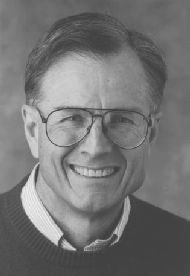

Richard McCray received his Ph.D. in theoretical physics from UCLA in 1967.  He was a Postdoctoral Fellow at Caltech (1967-68) and an Assistant Professor
at the Harvard College Observatory (1968-71). In 1971, he moved to the Joint
Institute for Laboratory Astrophysics at the University of Colorado at Boulder,
where he is now George Gamow Distinguished Professor of Astrophysics. He has
held visiting positions at the NASA Goddard Space Flight Center (1983), Beijing
University and Nanjing University (1987), the Space Telescope Science Institute
(1988), Columbia University (1990), and the University of California at Berkeley
(1997).
He was a Postdoctoral Fellow at Caltech (1967-68) and an Assistant Professor
at the Harvard College Observatory (1968-71). In 1971, he moved to the Joint
Institute for Laboratory Astrophysics at the University of Colorado at Boulder,
where he is now George Gamow Distinguished Professor of Astrophysics. He has
held visiting positions at the NASA Goddard Space Flight Center (1983), Beijing
University and Nanjing University (1987), the Space Telescope Science Institute
(1988), Columbia University (1990), and the University of California at Berkeley
(1997).
In 1983 Prof. McCray was awarded a Guggenheim Foundation Fellowship and in 1990 he received the Dannie S. Heinemann Prize for Astrophysics of the American Physical Society. In 1989 he was elected to National Academy of Sciences. In 1996 he was appointed Concurrent Professor of Astronomy at Nanjing University. In 2002 he was awarded the NSF Director's Award for Distinguished Teaching Scholars.
Currently, Prof. McCray is Chair of the NAS/NRC Committee on Undergraduate Science Education, Co-Chair of the NAS/NRC Committee on Astronomy and Astrophysics, a member of the NAS/NRC Space Studies Board, and Chair of the Astronomy Section of the NAS.

I have worked on a wide variety of topics in theoretical astrophysics, mostly having to do with the dynamics and kinetics of diffuse gas and the formation of spectra in various astrophysical systems, including interstellar gas, active galactic nuclei, binary X-ray systems, and supernova explosions. I also observe these systems with spacecraft such as the Hubble Space Telescope (HST) and the ASCA X-ray telescope. 
My primary interest during the past ten years has been SN1987A. Because it is the brightest supernova since Kepler's supernova SN1604, we have a far better view of SN1987A than of any other supernova. We have been able to observe the development of its entire electromagnetic spectrum, from radio to gamma rays, for more than ten years. Thanks to HST, we have images that resolve the expanding debris of the supernova and its remarkable system of three rings of circumstellar gas.
My research on SN1987A has two main goals. The first is to understand what its spectrum tells us about the physical properties of the debris - its distribution in element composition, temperature, and density. These are essential clues to the explosion mechanism of supernovae and to the role of supernovae in producing the heavy elements in the universe. To do this, I use computers to model the atomic, molecular, and radiative processes by which gamma rays from newly-synthesized radioactive elements are degraded into the X-ray, ultraviolet, optical, and infrared photons that escape from the debris and are observed at Earth.
The second goal of my research on SN1987A is to understand the nature of its circumstellar ring system. We suspect that these rings were expelled by the supernova progenitor star some 20,000 years before it exploded, but we don't understand the expulsion mechanism. The visible rings are probably only the ionized inner surfaces of a much greater mass of gas that we cannot see, because the supernova flash did not produce enough ionizing radiation to illuminate it. However, in 1991, Ding Luo and I predicted that the blast wave from the supernova would strike the inner ring in about 1997, and that when it did, the ring would brighten by a factors ~ 1000. Later, in 1997, Kazik Borkowski, John Blondin, and I predicted that we would also be able to see Lyman-alpha and H-alpha emission from the fast moving supernova debris as it crossed a shock front near the ring.
All of these predictions are coming true. In 1997, using the Space Telescope Imaging Spectrograph, we saw the predicted Lyman-alpha emission from the shock front. The observed intensity was close to the value we predicted. Also, with the Wide Field Camera on the HST, we saw a rapidly brightening "hot spot" on the inner ring, evidently marking the first place where the supernova blast wave struck the inner ring (see the image above). Now, in 2002, we see more than a dozen hot spots all around the ring. We expect that soon (say, within 5 years) the hotspots will merge so that the entire ring will be ablaze as it is overtaken by the supernova blast wave. This is the first time in history that astronomers can witness the birth of a supernova remnant in real time as the event unfolds. At the moment, we are observing the development of this crash intensively with the Hubble Space Telescope and with the Chandra and XMM X-ray observatories, and we are interpreting these observations in terms of hydrodynamic models for the shock interaction coupled with models for the radiation emission by the shocked gas.
We are also developing theoretical models to predict an exciting new phenomenon connected with this event. The shock interaction from the impact of the debris of SN1987A with the circumstellar ring is a new and rapidly brightening source of ionizing radiation. This radiation will propagate ahead of the shock and will ionize and heat the circumstellar gas, including the inner and outer rings and other gas which was expelled by the supernova progenitor and has remained invisible up to now. The gas will begin to glow as a result, so we should see the entire system begin to light up over the next decade or so.
For more details and images, see the section on SN1987A in my hypertext.
